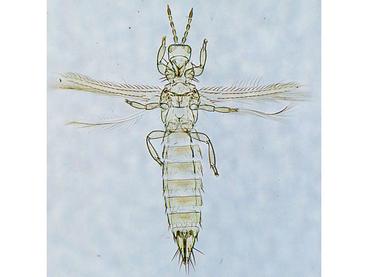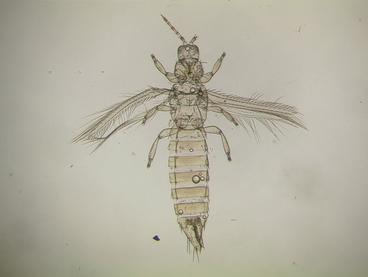SCIENTIFIC NAMES: Frankliniella tritici (Fitch) and F. bispinosa Morgan
CLASS: Insecta
ORDER: Thysanoptera
FAMILY: Thripidae


Description
Adults
The flower thrips and the Florida flower thrips are exceedingly similar. They can be separated onl by microscopic examination. Both are approximatel 1 mm to 1.25 mm long and yellow, with brown blotching, especially about the middle of the thorax and abdomen. Males are smaller than females and are lighter in color.
Eggs
The flower thrips delicate egg is cylindrical, and slightly kidney-shaped, with a smooth pale or yellow surface.
Larvae
The immature thrips is lemon yellow, resembling the adult except for its lack of wings.
Biology
Distribution
The Florida flower thrips has been found in Florida, Georgia, and Alabama and is likely distributed in other states of the southern United States. Evidently because of their small size, flower thrips are carried over large areas by frontal wind systems, the maximum rate of migration taking place in early week of June. Trapping records by sticky cards showed that these thrips are found in relatively equal numbers up to 135 feet (45 m). They have even been trapped at altitudes of 10,000 feet (3,100 m). The flower thrips has also been reported in western states. These thrips enter greenhouses through vents or doors, on plants brought into the house, or on people or supplies coming into the house.
Host Plants
Florida flower thrips have been reported from over one hundred species of plants. Roses and citrus are favorite hosts, particularly the white varieties. Most plants of the Rosaceae are infested. Flowers of a more or less open structure, where the stamens and pistils are easily accessible, are favorites. Flowers such as nightshade with stamens in a tube about the pistil are also favorites. Flower thrips have been collected from 29 plant orders including various berries, cotton, chrysanthemums, daisies, day lilies, field crops, forage crops, grass flowers, legumes, peonies, privet, roses, trees, truck crops, vines, and weeds. They seem to prefer grasses and yellow or light-colored blossoms. Roses are most susceptible in June.
Damage
Florida flower thrips always feeds on the most tender part of the plant, such as buds, flowers, or leaves. The effect of their numerous but shallow punctures is to give the injured tissue a shrunken appearance, and the damage is described as piercing and sucking fluids from the cells. The thrips feeds on the thick flesh petals, pistils, and stamens of the flower, and then the affected parts turn brownish-yellow, blacken, shrivel up, and drop prematurely. Infested rose blossoms turn brown, and buds open only partially. The petals, distorted with brown edges, seem to stick together. Only the epidermis and relatively few mesophyll cells are affected. They also may feed on the ovary or young fruit on some host plants. The numerous and shallow punctures on the surface cause characteristic markings that lower marketability dramatically.
Life Cycle
No published work has been done on the biology of the Florida flower thrips. The flower thrips was described in 1855 from Wisconsin. During warm periods, swarms of these tiny insects often fly in the afternoon. Flower thrips bite people, causing a noticeable stinging sensation. Their large numbers account for considerable and rapid damage to flowers, especially those with light-colored petals. Yet thrips contribute to pollination of some crops, an unexpected benefit! Flower thrips are generally found at the bases of the petals. They reproduce throughout the year in the warmer parts of the Southeast, with the majority of their 12 to 15 generations occurring in the warmer months. Newly emerged females begin to lay eggs within 1 to 4 days in summer and within 10 to 35 days in winter, reproduction being much faster in warmer weather. In summer, the adult stage is reached in about 11 days. Flower thrips pass through egg, two larval, prepupal, pupal, and adult stages. The eggs are inserted into flower or leaf tissue, and the prepupal and pupal stages are spent in the soil. In summer, flower thrips may live 26 days, though overwintering thrips may live all winter. Flower thrips can overwinter as far north as North Dakota in grass clumps and other sheltered refuges.